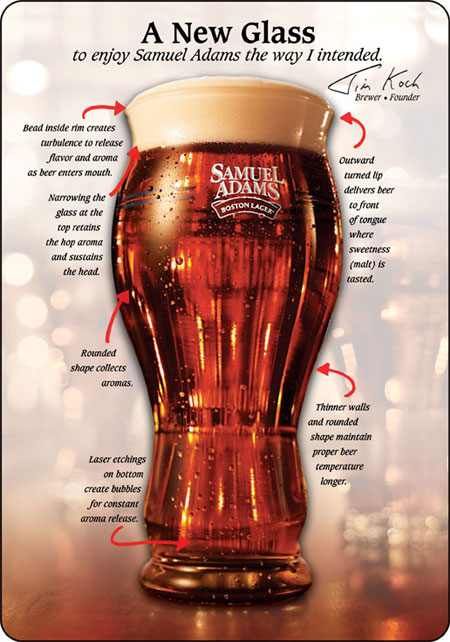|
Building a better beer glass
April 2007
You can't always believe what you read, not even here.
A couple of years ago we properly encouraged readers you get their beer out of that cocktail shaker into a glass that would beer show off its flavor. But to help you find a glass we suggested studying Michael Jackson's "Great Beer Guide" because the 500-plus beers featured there are pictured with glassware provided by their brewers.
That's where we went wrong. For instance, had you followed our advice and were pouring a Belgian "white" beer you'd turn to page 229 and see that Hoegaarden Witbier was served in a flower-pot shaped glass with Hoegaarden printed on the front. The brewery likely was thinking about how its beer would taste when it had the glass designed, right?
Nope.
When Boston Beer Co. founder Jim Koch started talking to European glassmakers about turning the concept for a special glass for Samuel Adams Boston Lager into the actual glass he found that out. "They were consistent in saying nobody is designing glassware around function," he said.
Now Samuel Adams has. It sounds simpler than it turned out to be. Boston Beer's brewers described what they wanted their beer to look like, smell like and taste like to a team from Tiax, a Boston-area company that for decades has worked with food, beverage and pharmaceutical companies to create and enhance products.

"They gave us a wish list of what they wanted to call out," said Jonaki Egenolf, manager for technology marketing.
Koch filled his office with more than 100 glasses as part of the process, but Tiax used those only for reference. "That way we were able to better understand what they wanted and to correlate the sensory experience," Egenolf said.
"We did flavor profiles starting with aroma, flavor and aftertaste," said Sarah Garretson Lowery, the sensory analyst for the project. For instance, panelists - all with at least five years experience, including some with beer - assessed aroma on a seven-point scale, just one stop along a complete checklist.
"We weren't evaluating beer 'for liking,'" said Egenolf.
"We're using attributes that can be measured," said Garretson Lowery. "And we're looking at flavor structure."
Tiax spent almost three months on the project before handing over a 300-page report. "We provided them more of a Frankenstein glass," Egenolf said. "Here's what could happen at the top, here's what could happen in the middle, at the bottom, and what the tradeoffs would be."
Koch took that to a half-dozen glassmakers and Rastal came up with the final glass. Both Egenolf and Garretson were impressed.
"A shaker, a brandy snifter, a tulip glass, they all provided difference experiences that seemed OK," Egenolf said, "but this glass really made a difference in how I experienced the beer."
Garretson Lowery was more specific. "The most important difference is how the aromatics are sustained," she said.
Koch is just as happy. "When we finally went from prototype to glass the cumulative effect was gratifying," he said. "I was pleasantly surprised.
"This is not revolutionary. PBR (Pabst Blue Ribbon) is not going to taste like Sam Adams in this glass," he said. "It was designed to make Sam Adams taste more like Sam Adams."
In the past, Samuel Adams sometimes shipped a tall pilsner glass along with its Boston Lager in press kits. Not any more. "That's the wrong glass," Koch said. "It dumps the beer in the back and you get bitterness too early. This glass enhances the initial impression of malt sweetness."
The accompanying illustration shows just how the glass is intended to function. Koch makes it easier to understand. "To me it is a procession across your tongue. It starts with body, then sweetness, spiciness and bitterness. That is the sequence we want," he said.
Boston Beer is introducing the glass with care. For instance, New Mexico starts with just 40 cases (24 glasses per case). Coasters were designed to explain why the glass is different.
"Bartenders are not there to give people an education. You can't get to every waitress," Koch said. "We don't want this to wind up like one more glass promotion. We want to educate people that beer deserves the same respect wine does."
Koch does not portray this as the beer glass to end all beer glasses. Many other glasses out there work just fine - although not the flower pot for "white" beers (the aroma gets sprayed rather than collected).
"I can't vouch that our glass will improve the experience for anybody else's beer. It was designed to better express the intentions of our brewers," he said. "How it is for other beers, that's for those brewmasters to say. Not me."
Instead, think of it as a beginning.
"I hope this peaks the interest of other brewers. When we consider glassware let's consider what it does to the taste of the beer," he said.
| 
